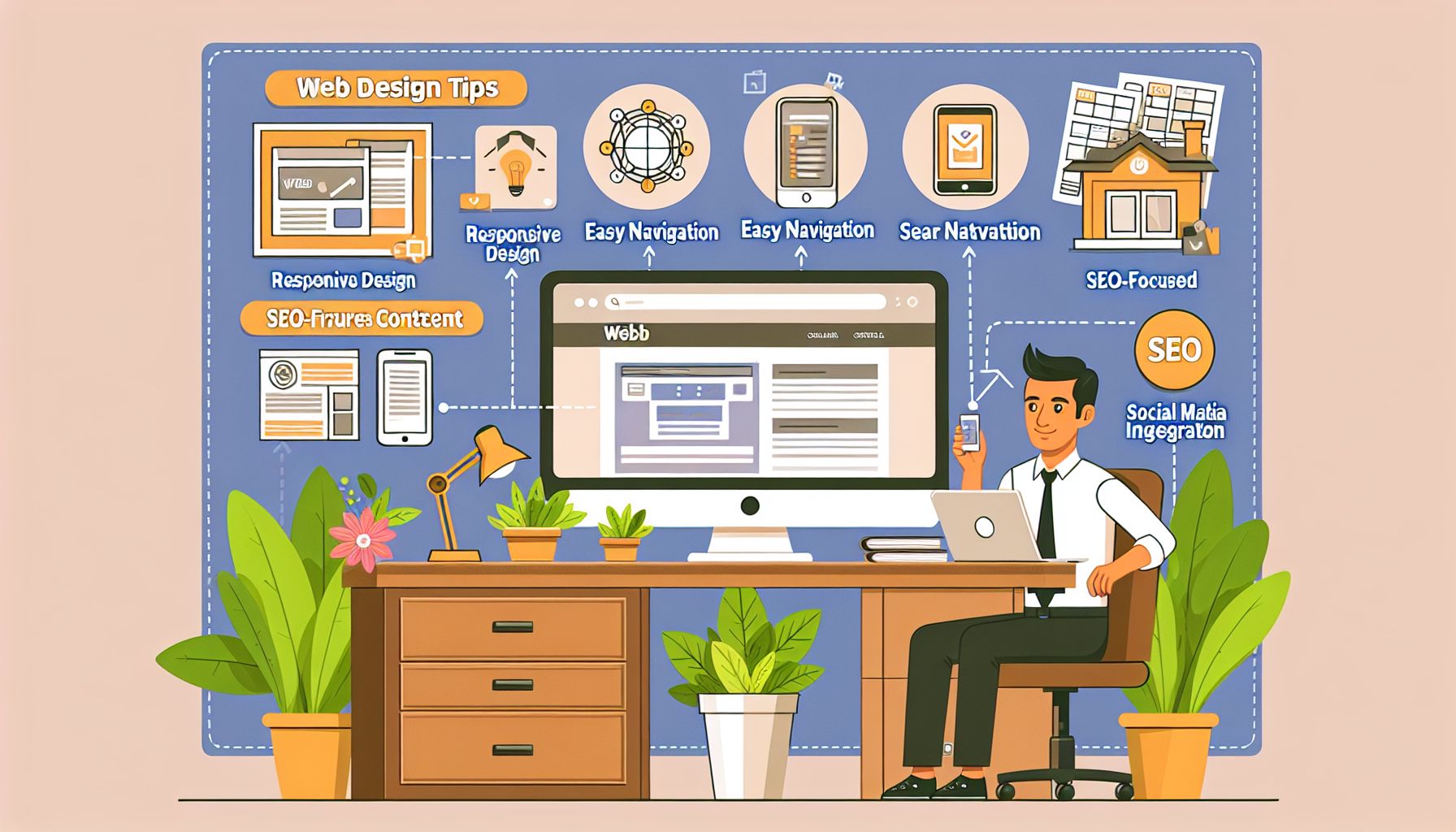Monthly Archives: January 2024


Web Design Tips for Small Business Owners
Starting a small business is an exciting venture, but it also comes with its fair share of challenges. One of the most crucial aspects of running a successful business in today’s digital age is having an effective online presence. And at the heart of that online presence is a well-designed website. In this article, we will discuss some essential web design tips specifically tailored for small business owners.
Why is Web Design Important?
First impressions matter, and when it comes to your business, your website is often the first point of contact for potential customers. A poorly designed website can leave a negative impression and drive potential customers away. On the other hand, a well-designed website can convey professionalism, trustworthiness, and competence, helping you attract and retain customers.
Keep it Simple
When it comes to web design, simplicity is key. As a small business owner, you want to ensure that your website is easy to navigate and user-friendly. Avoid cluttering your website with unnecessary elements, excessive text, or overwhelming colors. Keep your design clean and minimalist, focusing on providing relevant and concise information.
Create a Consistent Brand Identity
Your website should reflect your brand identity. Consistency in design is crucial to create a lasting impression and build trust with your customers. Use your brand colors, fonts, and logo consistently throughout the website, ensuring that each page has a unified look and feel. Consistency in branding helps customers associate your website with your business, making it easier for them to recognize and remember you.
Optimize for Mobile
In today’s mobile-centric world, having a mobile-friendly website is no longer an option; it’s a necessity. A significant portion of internet users access websites through mobile devices, and if your website is not optimized for mobile, you risk losing potential customers. Ensure that your website is responsive, meaning it adapts and displays correctly on all screen sizes and devices. A user-friendly mobile experience is crucial for attracting and engaging with mobile users.
Make Navigation Intuitive
A well-organized and intuitive navigation menu is essential for guiding users through your website seamlessly. Place your menu in a prominent location, such as the top of the page, and clearly label each section. Avoid using complex dropdown menus that can confuse users. Keep the navigation menu simple and logical, making it easy for users to find the information they are looking for.
Optimize Page Load Speed
Fast page load speed is crucial for user experience. Research shows that users tend to abandon websites that take too long to load. Optimizing your website’s performance will not only please your users but can also improve your search engine rankings. Some ways to enhance page load speed include optimizing image sizes, minimizing HTTP requests, and utilizing caching.
Include Clear Call-to-Actions
Your website serves a purpose: to convert visitors into customers. To do this effectively, be sure to include clear and compelling call-to-actions (CTAs) throughout your website. Whether it’s to make a purchase, sign up for a newsletter, or contact your business, CTAs help guide users towards the desired action. Use strong and concise language that grabs attention and encourages users to take the next step.
Utilize High-Quality Imagery
In web design, a picture is worth a thousand words. High-quality and relevant imagery can significantly contribute to the overall look and feel of your website. Invest in professional photography or use stock images that align with your brand identity. Avoid using low-resolution or generic images that can undermine the credibility of your business.
Test and Optimize
Web design is an ongoing process. Once your website is live, it’s important to track its performance and continuously make improvements. Utilize analytics tools to gather data on user behavior, such as bounce rate, time on page, and conversion rate. This data can provide valuable insights on how to optimize your website further and improve its effectiveness.
Conclusion
As a small business owner, a well-designed website is a powerful tool to establish your online presence, attract customers, and drive business growth. By keeping it simple, consistent, and optimized for mobile, while also focusing on intuitive navigation, page load speed, clear CTAs, and high-quality imagery, you can create a website that stands out and helps your business thrive in the digital world. Remember, a great website not only reflects your business but also offers a seamless and enjoyable experience for your customers.


Web Design Tips for Small Business Owners
In today’s digital age, having a strong online presence is essential for small businesses to thrive. One of the key aspects of establishing this presence is designing a website that not only looks visually appealing but also functions seamlessly. A well-designed website can make a significant difference in attracting and retaining customers. So, where do you start if you’re a small business owner looking to enhance your online presence? Here are some valuable web design tips that will help your business make a lasting impression online.
Understand Your Brand Identity
Before diving into the world of web design, it’s crucial to have a clear understanding of your brand identity. Your website should reflect your brand’s values, tone, and overall image. Start by creating a style guide that outlines your brand colors, fonts, and any specific design elements that represent your business. Having this guide will ensure consistency throughout your website and align it with your offline marketing materials.
Keep It Simple and User-Friendly
When it comes to web design, simplicity is key. Avoid cluttering your website with excessive content, images, or flashy effects. Instead, aim for a clean and minimalistic design that is easy for users to navigate. Make sure your website is organized logically, with clear menu options and a user-friendly interface. Remember, visitors should be able to find the information they’re looking for within seconds.
Mobile Responsiveness Is a Must
Since the majority of internet users access websites through their mobile devices, having a responsive design is no longer optional. Ensure that your website is optimized for all screen sizes, from desktops to smartphones and tablets. A responsive design allows your website to adapt to different devices seamlessly, providing visitors with an excellent user experience regardless of how they access your site.
Utilize High-Quality Visuals
When it comes to visuals, quality is vital. Invest in professional photography or use high-resolution images that represent your brand effectively. Avoid using generic stock photos and opt for original visuals that help convey your brand’s story. Additionally, consider incorporating videos or interactive elements to engage and captivate your visitors, encouraging them to spend more time on your website.
Incorporate Clear Calls to Action
A website with a beautiful design is excellent, but it won’t benefit your business if it doesn’t engage visitors and convert them into customers. Include clear and compelling calls to action throughout your website to guide users towards the actions you want them to take. Whether it’s making a purchase, booking a consultation, or signing up for a newsletter, a well-placed call to action can significantly increase your conversion rates.
Optimize for Search Engines
Having a visually appealing website is essential, but it’s equally important to optimize it for search engines. Implementing basic Search Engine Optimization (SEO) techniques can improve your website’s visibility in search engine results, making it easier for potential customers to find you. Conduct keyword research specific to your business, incorporate those keywords naturally into your website’s content, and optimize your meta tags and headings.
Ensure Fast Loading Times
In today’s fast-paced world, users expect websites to load quickly. If your website takes too long to load, visitors are likely to leave and look for alternatives. Optimize your website’s loading times by compressing images, minimizing code, and leveraging browser caching. Regularly check your website’s loading speed using tools like Google PageSpeed Insights to identify areas for improvement.
Monitor and Analyze Your Website’s Performance
Once your website is up and running, your job isn’t over. Continuously monitor and analyze your website’s performance using web analytics tools like Google Analytics. By tracking metrics such as site traffic, bounce rate, and conversion rates, you can identify areas of improvement and make data-driven decisions to enhance your website and overall online strategy.
Conclusion
In today’s digital landscape, a well-designed website is essential for small businesses to succeed. By understanding your brand identity, keeping your design simple and user-friendly, optimizing for mobile devices, and incorporating clear calls to action, you can create a website that stands out from the competition. Don’t forget to optimize your website for search engines, ensure fast loading times, and consistently analyze your website’s performance. Following these web design tips will help your small business establish a strong online presence, attract customers, and achieve your business goals.


Web Design Tips for Small Business Owners
Are you a small business owner looking to create or improve your website? In today’s digital world, having an effective online presence is crucial for success. Your website design plays a significant role in attracting and engaging potential customers. To help you make the most of your web design, we’ve compiled some essential tips tailored specifically for small business owners.
Introduction: Why Web Design Matters
Your website is often the first point of contact between your business and potential customers. A well-designed website can quickly capture visitors’ attention, build trust, and ultimately convert them into loyal customers. On the other hand, a poorly designed website can lead to high bounce rates and lost opportunities.
1. Keep it Simple and User-Friendly
When it comes to web design, simplicity is key. Avoid overwhelming visitors with cluttered layouts and excessive content. Opt for a clean and organized design that makes it easy for users to navigate your website. Ensure your site is mobile-friendly since more and more users are accessing the internet via their smartphones.
2. Be Consistent with Branding
Your website should align with your brand identity. Consistency in colors, fonts, and overall design helps create a strong and memorable brand image. Ensure your logo is prominently displayed and utilizes high-quality imagery on your site. This will enhance your credibility and make your business appear professional.
3. Prioritize Clear Call-to-Actions (CTAs)
Guide your visitors through their journey on your website by incorporating clear and relevant CTAs. Whether it’s “Subscribe,” “Buy Now,” or “Contact Us,” strategically position these buttons to drive conversions. Use contrasting colors and enticing wording to make your CTAs stand out. Remember, the easier it is for visitors to find what they’re looking for, the more likely they are to take action.
4. Optimize for Search Engines
Having a visually appealing website is not enough; you also need to be found by search engines. Implement basic search engine optimization (SEO) practices such as using relevant keywords, meta tags, and optimizing page load speeds. Ensure your website content is user-focused, informative, and regularly updated, as search engines prioritize delivering valuable content to users.
5. Incorporate High-Quality Visuals
Humans are visual creatures, and a picture is worth a thousand words. Use high-quality images and engaging visuals to capture visitors’ attention and communicate your brand story effectively. Avoid generic stock photos whenever possible, as they can detract from your authenticity. Consider hiring a professional photographer or investing in custom illustrations to showcase your unique offerings.
6. Tweak for Conversion Rate Optimization (CRO)
Optimizing your website’s design for better conversion rates is vital. Experiment with different elements such as button placement, color schemes, or form designs to analyze what works best for your audience. Use website analytics tools to track visitor behavior and test different versions of your site to identify the most effective design elements that maximize conversions.
7. Ensure Fast and Responsive Loading
Did you know that a slow-loading website can lead to frustrated users and a higher bounce rate? Optimizing your website’s loading time is crucial to keep visitors engaged. Compress image files, minimize server requests, and implement caching techniques to improve website speed. Additionally, ensure your website design is responsive, so it adapts seamlessly to different devices and screen sizes.
Conclusion: Your Website, Your Business Ambassador
In the digital age, a well-designed website is the face of your business. It serves as a 24/7 representative and can be a significant driver of growth. By keeping your website simple, consistent with your branding, and optimizing it for both users and search engines, you’ll create a powerful online presence. Remember to provide valuable content and continually refine your design based on user behavior to stay ahead of the competition. Embrace web design as a tool to connect with your audience, inspire trust, and turn visitors into loyal customers.
Now, it’s your turn to unleash the power of web design for your small business. Start creating an impactful website that truly represents your brand and helps you achieve your business goals!


SEO for Business Owners: Boost Your Online Visibility and Attract More Customers
In today’s digital age, having a strong online presence is crucial for every business. Whether you own a small local shop or a large multinational corporation, search engine optimization (SEO) can significantly impact your success. By implementing effective SEO strategies, you can improve your website’s visibility, drive organic traffic, and attract more potential customers. In this article, we’ll explore the fundamentals of SEO and provide valuable insights for business owners looking to harness its power.
What is SEO and why does it matter?
SEO is the process of optimizing your website and its content to rank higher in search engine results pages (SERPs) organically. When potential customers search for products or services related to your business, you want to ensure that your website appears at the top of the search results. Studies have shown that users are more likely to click on the top-ranking links, which means better visibility can lead to more website traffic and ultimately more customers.
Key SEO techniques for business owners
-
Keyword research: Keywords are the foundation of SEO. Conduct thorough research to identify the most relevant and frequently used keywords in your industry. This will guide your content creation and optimization efforts, allowing you to target the right audience and increase your chances of ranking higher on relevant searches.
-
On-page optimization: Optimizing your website’s on-page elements is essential. Ensure that your chosen keywords are strategically placed in the title tags, meta descriptions, headings, and content. However, avoid keyword stuffing as search engines prioritize user experience and penalize over-optimized websites.
-
Quality content creation: Publishing high-quality, relevant, and informative content is key to SEO success. Not only does it help you establish authority and trust with your audience, but it also increases the likelihood of other websites linking back to your content, which boosts your search rankings.
-
Website speed optimization: Website speed is a crucial factor that affects both user experience and search rankings. Slow-loading websites can frustrate users and lead to higher bounce rates. Optimize your website’s performance by compressing images, minifying code, and utilizing caching techniques.
-
Mobile optimization: With the increasing use of smartphones, mobile optimization is no longer optional. Ensure your website is mobile-friendly, with a responsive design that adapts seamlessly to different screen sizes. Mobile optimization is not only essential for user experience but also a factor considered by search engines when ranking websites.
-
Link building: Building a strong network of high-quality backlinks is a critical aspect of SEO. Focus on obtaining links from reputable and relevant websites within your industry. Guest posting, participating in industry forums, and creating shareable content are effective ways to generate backlinks.
-
Social media integration: While social media directly does not impact search rankings, it can contribute indirectly. By engaging with your audience on social platforms and promoting your content, you increase the chances of it being shared and linked to, thus boosting its visibility and SEO value.
The importance of local SEO
If your business primarily caters to a local audience, investing in local SEO is essential. Optimize your website for local searches by including location-specific keywords, creating a Google My Business (GMB) profile, and getting listed in local directories. Encourage happy customers to leave positive reviews, as they can significantly impact your local search rankings.
Monitoring and continuous improvement
SEO is an ongoing process that requires monitoring and continuous improvement. Regularly analyze your website’s performance using tools like Google Analytics and Google Search Console. Pay attention to important metrics such as organic traffic, bounce rates, and keyword rankings. This data will provide valuable insights into what’s working and what needs improvement.
Conclusion
By incorporating SEO strategies into your digital marketing efforts, you can significantly enhance your online visibility and reach a wider audience. Remember that SEO is a long-term investment that requires dedication and patience, but the rewards are worth it. Keep up with the latest SEO trends and algorithm updates to stay ahead of your competition. With the right SEO strategies in place, you’ll be well on your way to attracting more customers and growing your business online.


How to Master SEO for Your Small Business
If you own a small business, you already know that it can be challenging to compete with bigger brands in the online world. Search engine optimization (SEO) is one of the most effective ways to level the playing field and drive more traffic to your website. In this article, we will explore the importance of SEO for small business owners and provide some practical tips to help you get started.
Why is SEO important for small businesses?
SEO is essential for small businesses because it helps increase your online visibility, attract more targeted traffic, and ultimately, generate more sales. Here are some key reasons why you need to pay attention to SEO:
-
Improved organic search rankings: By optimizing your website for search engines, you have a higher chance of appearing in the top results when users search for relevant keywords.
-
Enhanced user experience: SEO goes hand in hand with improving the overall user experience on your website. This includes making it mobile-friendly, easy to navigate, and providing valuable content to your audience.
-
Cost-effective marketing: Compared to traditional advertising methods, SEO is a cost-effective marketing strategy. It allows you to target specific keywords and reach potential customers who are actively searching for your products or services.
Getting started with SEO
Now that you understand the importance of SEO for your small business, let’s dive into some practical tips to help you get started:
1. Conduct keyword research
Keyword research is the foundation of any successful SEO campaign. Start by identifying the keywords that your target audience is likely to use when searching for products or services similar to yours. Use tools like Google Keyword Planner or SEMrush to find high-volume keywords with low competition.
2. Optimize your website
Once you have a list of targeted keywords, it’s time to optimize your website. Pay attention to the following elements:
-
Title tags: Include your primary keyword in the title tags of your web pages. Keep them concise, descriptive, and unique to improve your chances of ranking higher in search results.
-
Meta descriptions: Write compelling meta descriptions that accurately describe the content of each page. Be sure to include your targeted keywords, but avoid keyword stuffing.
-
Headers: Utilize header tags (H1, H2, H3) to structure your content and make it more readable. Incorporate your keywords naturally within the headers to signal their importance to search engines.
-
URL structure: Make sure your URLs are clean, concise, and contain relevant keywords. Avoid using long, complicated URLs that can confuse both users and search engines.
3. Create quality content
Content is king when it comes to SEO. Producing high-quality, valuable content is crucial for attracting and retaining your target audience. Use your targeted keywords strategically within your content but prioritize providing valuable information to your readers. Regularly update your website with new and fresh content to signal to search engines that your website is active and relevant.
4. Build quality backlinks
Backlinks are important for establishing your website’s credibility and authority. Seek opportunities to have other reputable websites link back to your content. This can be accomplished through guest blogging, influencer outreach, or creating shareable and valuable content that others will naturally want to link to.
5. Leverage local SEO
If your small business relies on local customers, it’s crucial to focus on local SEO. Optimize your website for local keywords and make sure your business information is consistent and up to date on various online directories such as Google My Business, Yelp, and Bing Places. Encourage your customers to leave positive reviews, as these can significantly impact your local search rankings.
Conclusion
SEO may seem daunting at first, but by implementing these strategies, you can make a significant impact on your small business’s online presence. Remember to continuously monitor and adapt your approach as search engine algorithms and best practices evolve. With patience and persistence, SEO can become a powerful tool to help your small business thrive in the competitive digital landscape. So, don’t wait any longer. Start implementing these SEO tactics today and watch your small business grow!